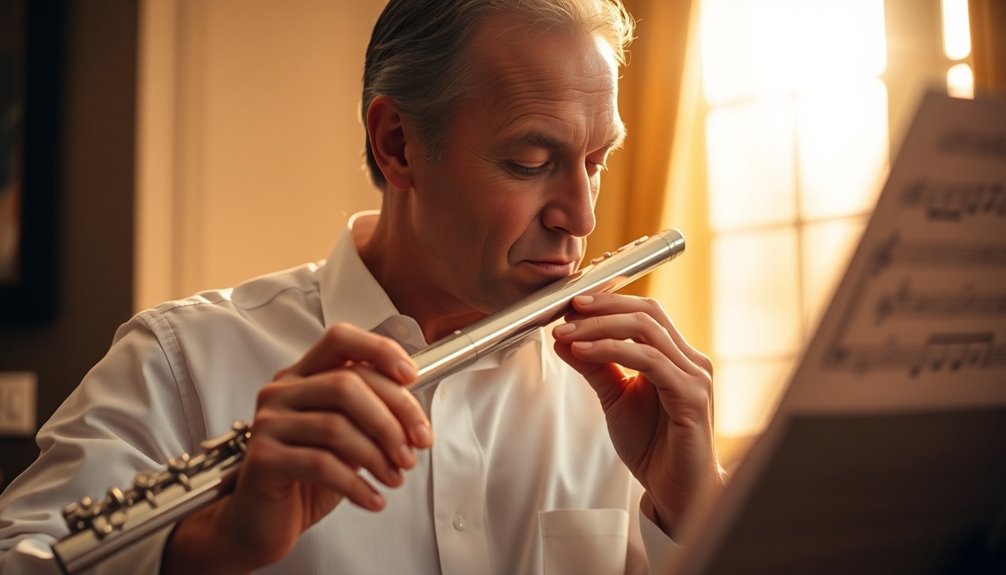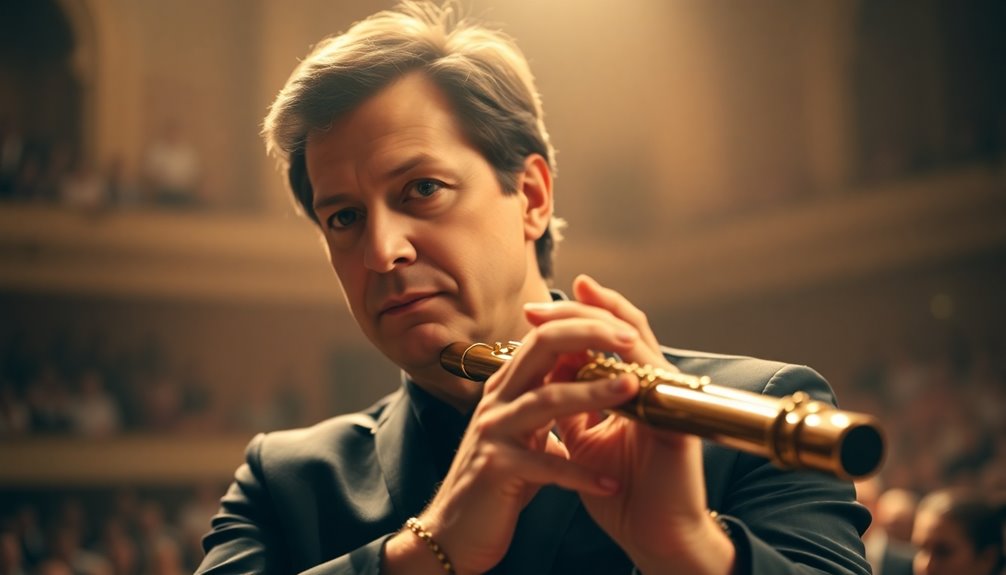As a flute enthusiast, you should know five iconic musicians who have left an indelible mark on the instrument. Jean-Pierre Rampal is celebrated for bringing the flute to life in classical music. James Galway captivates with his rich tone and innovative techniques. Julius Baker revolutionized teaching methods, influencing many notable flutists. Emmanuel Pahud embodies contemporary mastery, blending technical precision with deep musicality. Finally, Robert Langevin's emotional performances and educational contributions inspire aspiring flutists. Together, these musicians not only highlight the flute's versatility but also encourage a vibrant community in music. Discover more about their remarkable contributions and techniques!
Key Takeaways
- Jean-Pierre Rampal revolutionized flute performances, enhancing its presence in orchestras with his expressive breath control and unique vibrato.
- James Galway captivates audiences with his enchanting sound, blending classical and popular styles while promoting experimentation among flutists.
- Julius Baker is celebrated for his exceptional teaching methods, emphasizing tone quality and fostering individuality among students, influencing many successful flutists.
- Emmanuel Pahud is known for his technical precision and musicality, mentoring young flutists to explore their unique musical identities.
- Robert Langevin, principal flutist of the New York Philharmonic, showcases emotional depth in performances and contributes to flute education and repertoire.
Jean-Pierre Rampal

Jean-Pierre Rampal is often celebrated as one of the most influential flutists of the 20th century, and for good reason. His extraordinary ability to convey emotion through music set a new standard for flutists everywhere. You might find that Rampal's techniques, which combined impeccable breath control and a unique vibrato, transformed the way the flute was perceived in classical music. He championed the instrument, bringing it to the forefront of orchestras and chamber ensembles, showcasing its versatility and richness.
Rampal didn't just play the flute; he breathed life into it. His performances were marked by a distinctive clarity and warmth, making even the most complex passages sound effortless. You can't help but feel a connection to his artistry, as he made the flute sing in ways that resonated deeply with audiences. This was part of Rampal's legacy: he opened doors for countless flutists, inspiring them to explore new techniques and repertoires.
Beyond his technical prowess, Rampal's contribution to music education can't be overlooked. He believed in the importance of teaching, sharing his knowledge with aspiring flutists. His emphasis on breath control helped shape the practices of many flutists who followed in his footsteps.
If you're looking to deepen your understanding of flute playing, studying his recordings and techniques is invaluable. Rampal's legacy lives on, reminding us that music is a shared journey, and through his example, you're encouraged to embrace your own path as a flutist, fostering a sense of belonging within this vibrant community.
James Galway

Since the 1970s, James Galway has captivated audiences worldwide with his enchanting flute performances, establishing himself as a prominent figure in both classical and popular music. His unique approach and mastery of the flute have inspired countless musicians and enthusiasts alike.
You'll find that Galway's techniques aren't just impressive; they're transformative, elevating the flute's role in various musical genres.
Here are four key aspects of Galway's artistry that every flute enthusiast should appreciate:
- Signature Sound: Galway's rich tone and dynamic range make his performances instantly recognizable, showcasing the flute's versatility.
- Innovative Techniques: From breath control to intricate fingerings, his techniques push the boundaries of what's possible on the flute, encouraging you to experiment and grow.
- Flute Collaborations: Over the years, Galway has teamed up with a variety of artists, from classical musicians to pop stars, demonstrating the flute's adaptability across genres.
- Educational Contributions: Through masterclasses and instructional materials, he shares his knowledge and passion, fostering a sense of community among flute players.
In addition to his performances, Galway emphasizes the importance of regular practice in developing one's skills and confidence on the flute.
When you explore Galway's work, you'll discover not just music but a profound sense of belonging within the flute community.
His influence extends beyond the stage, inspiring you to explore your own musical journey and connect with others who share your love for the flute.
Whether you're a novice or a seasoned player, Galway's legacy is one you'll want to embrace.
Julius Baker

Celebrated for his exceptional teaching prowess, Julius Baker has profoundly influenced the world of flute playing through his innovative methods and dedication to his students. If you've ever marveled at the artistry of today's top flutists, you might just be witnessing the impact of Baker's techniques. His approach to teaching emphasized the importance of sound production, tone quality, and musical expression, which has become foundational for many aspiring flutists.
Baker understood that each student has a unique voice, and he nurtured this individuality. With a keen eye for detail, he tailored his instruction to meet the specific needs of each student, ensuring that they not only mastered the flute but also developed a deep, personal relationship with the music. This personalized approach is what set him apart and made him a revered figure in the music community.
Among his influential students, you'll find notable names like James Galway and Jean-Pierre Rampal, who've carried forward Baker's legacy in their performances. Their successes highlight how Baker's techniques continue to resonate within the flute world. By embracing his principles, you'll find that you can elevate your own playing and deepen your understanding of the instrument. Additionally, incorporating ergonomic finger supports can significantly enhance your comfort during practice, a concept that aligns with Baker's emphasis on personalized instruction.
In a world where connection and mentorship matter, knowing about Julius Baker allows you to appreciate the traditions and teachings that shape flutists today. His influence is a reflection of the power of dedicated teaching, reminding you that great musicians often stand on the shoulders of giants.
Emmanuel Pahud

Building on the legacy of great teachers like Julius Baker, Emmanuel Pahud stands out as one of the most renowned flutists of our time. His mastery and innovation haven't only enriched the flute repertoire but have also inspired countless musicians.
Pahud's techniques are an essential part of his compelling performances, showcasing his ability to blend technical precision with profound musicality.
Here are four key aspects of Emmanuel Pahud's contributions to the world of flute music:
- Pahud Techniques: His approach to breath control and articulation sets him apart, allowing for a fluid and expressive sound that captivates audiences.
- Pahud Collaborations: He's performed with esteemed orchestras and chamber groups worldwide, fostering a sense of community among musicians and enriching the collective experience of music.
- Broad Repertoire: Pahud dives into everything from Baroque to contemporary works, showcasing his versatility and commitment to expanding the flute's presence in various genres.
- Mentorship: He actively teaches and mentors young flutists, passing on his knowledge and inspiring the next generation to explore their own musical identities.
Additionally, Pahud's incorporation of advanced techniques into his performances exemplifies his dedication to pushing the boundaries of traditional flute playing.
Whether you're an aspiring flutist or a devoted fan, understanding Pahud's journey and techniques can deepen your appreciation for the artistry involved in flute performance.
Embrace the legacy of this iconic musician, and let it inspire your own musical path.
Robert Langevin

Celebrating the artistry of Robert Langevin reveals a flutist whose contributions to the music world resonate deeply with both audiences and aspiring musicians. As the Principal Flute of the New York Philharmonic, Langevin's mastery of the instrument showcases not only his exceptional technical skills but also his profound musicality.
You'll find that his Langevin performances are marked by an emotional depth that captivates listeners, making each concert an unforgettable experience.
Langevin techniques are something every flutist can learn from. His approach emphasizes clarity, precision, and expressive phrasing, key elements that elevate any performance.
Whether you're a beginner or an experienced player, you can incorporate these techniques into your practice. By focusing on tone production and breath control, you'll discover how to create the lush, vibrant sound Langevin is known for.
Moreover, Langevin's interpretation of both classical and contemporary pieces demonstrates his versatility and willingness to push boundaries. His collaborations with renowned composers and soloists highlight his innovative spirit, inspiring you to explore new repertoires and styles.
In essence, Robert Langevin invites you into a world where tradition meets modernity, encouraging you to express your unique voice through the flute. Incorporating scales and arpeggios into your practice can further enhance your technical proficiency and musical expression.
His influence extends beyond the concert hall, fostering a community of musicians enthusiastic to learn and grow. By embracing Langevin's artistry and techniques, you're not just enhancing your skills—you're becoming part of a rich musical legacy that continues to inspire flutists everywhere.
Frequently Asked Questions
What Are the Signature Techniques of These Iconic Flutists?
When exploring the signature techniques of iconic flutists, you'll notice their mastery of extended techniques and exceptional breath control.
These musicians often utilize multiphonics, flutter-tonguing, and harmonics to create unique sounds that captivate audiences.
Their breath control allows for seamless shifts and dynamic expression, making their performances unforgettable.
How Did Each Musician Influence Modern Flute Playing?
Each musician you admire has shaped modern flute playing in unique ways.
Their flute innovations pushed boundaries, introducing new techniques that you likely practice today. By incorporating elements from diverse genres, they've enriched modern pedagogy, encouraging you to explore different styles.
Their dedication to expressive playing inspires you to connect emotionally with your audience.
You'll find that understanding their influence not only enhances your skills but also deepens your appreciation for the flute's evolving legacy.
What Notable Compositions Feature Their Performances?
Imagine a garden where each flower blooms with its own melody.
In this vibrant landscape, you'll discover notable recordings that showcase exquisite flute compositions. These pieces, rich in emotion and technique, invite you into a world where each note dances gracefully.
As you listen, you'll find that these performances not only highlight the musicians' artistry but also inspire your own journey with the flute, fostering a deep sense of belonging in the musical community.
What Styles or Genres Do These Musicians Specialize In?
You'll find that these musicians often specialize in diverse styles, blending genres seamlessly. They thrive in jazz fusion, where improvisation and rich harmonies create vibrant soundscapes.
Classical improvisation also plays a significant role, allowing them to showcase their technical skills and emotional depth.
Are There Any Notable Collaborations Among These Flutists?
You might be surprised to find how many iconic recordings stem from collaborative projects among flutists.
These musicians often join forces, blending their unique styles to create something truly special. For instance, you'll discover breathtaking collaborations that span genres, showcasing their versatility and artistry.
Conclusion
So, there you have it—five flute legends who've transformed mere breath into breathtaking music. From Rampal's suave elegance to Galway's charming charisma, these maestros prove that flutes aren't just for school bands and Renaissance fairs. Who knew blowing into a tube could lead to such fame? Next time you pick up your flute, remember: you might not reach their heights, but at least you won't need a royal invitation to make some noise! Happy playing!






